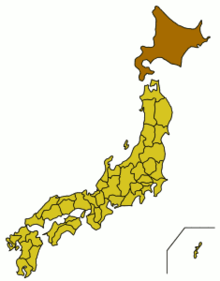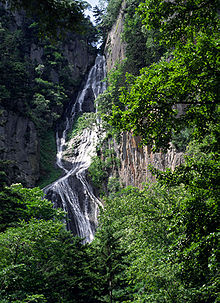Hokkaidō
Appearance



Hokkaidō (
Hokkaidō Prefecture covers the entire island.[2]
About 5,224,614 people live on the island. [3]It is north of Honshu. It is the second largest Japanese island.[4] It has a humid continental climate (Dfa/Dfb in the Köppen climate classification) with cold snowy winters and warm to hot summers.
Agriculture is an important part of the island's economy.
Regions
[change | change source]Hokkaidō region is one of Japan's traditional geographic regions.[5]
The region covers the entire island.[1] The island and the region have been called Hokkaidō since 1869.[4]
Related pages
[change | change source]References
[change | change source]- ↑ 1.0 1.1 Library of Congress Country Studies, Japan (LOC), "Geographic Regions, Hokkaido". Retrieved 13 February 2012.
- ↑ Japan External Trade Organization (JETRO), Hokkaido Prefecture, Regional Information Archived 27 January 2013 at the Wayback Machine. Retrieved 6 April 2012.
- ↑ "
北海道 データブック2023_人口 ・生活 -総合 政策 部 知事 室 広報 広 聴課". www.pref.hokkaido.lg.jp. Retrieved 15 February 2024. - ↑ 4.0 4.1 Nussbaum, Louis-Frédéric. (2002). "Hokkaido" in Japan Encyclopedia, p. 343.
- ↑ Nussbaum, "Geography" at p. 242.
Other websites
[change | change source]![]() Media related to Hokkaido at Wikimedia Commons
Media related to Hokkaido at Wikimedia Commons
